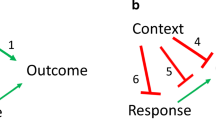Abstract
In order to investigate cognitive versus traditional accounts of responding in extinction and the discrimination hypothesis for the partial reinforcement effect, 40 human subjects were randomly divided into two groups and were treated according to thermal vasomotor conditioning procedures using either 25 trials of continuous reinforcement or 100 trials of 25% partial reinforcement. At the onset of extinction, half of each group was given traditional noninformed extinction, while the other (informed) half had the thermal stimulator removed. The usual greater resistance to extinction was obtained after partial reinforcement than after continuous reinforcement in the two noninformed groups; however, immediate extinction of responding was obtained from the first extinction trial in the two informed groups. These results are consistent both with the discrimination hypothesis for the partial reinforcement extinction effect and with cognitive explanations of responding in extinction. Consequences for the behavioral therapies are discussed.
Similar content being viewed by others
References
Baer, P. E., and Fuhrer, M. J.: Cognitive processes in the differential trace conditioning of electrodermal and vasomotor activity.Journal of Experimental Psychology, 84, 176–178, 1970.
Brewer, W. F.: There is no convincing evidence for opérant or classical conditioning in adult humans. In W. B. Weimer and D. S. Palermo (Eds.):Cognition and the Symbolic Processes. Hillsdale, N. J.: Lawrence Erlbaum Associates, 1974.
Bridger, W. H., and Mandel, I. J.: Abolition of the PRE by instruction in GSR conditioning.Journal of Experimental Psychology, 69, 476–482, 1965.
Brown, C. C.:Methods in Psychophysiology. Baltimore: Williams and Wilkins, 1967.
Bykov, K. M.:The Cerebral Cortex and the Internal Organs. Moscow: Foreign Languages Publishing House, 1959.
Campbell, D., Sanderson, R. E., and Laverty, S. G.: Characteristics of a conditioned response in human subjects during extinction trials following a single traumatic conditioning trial.Journal of Abnormal and Social Psychology, 68, 627–639, 1964.
Creelman, M. B.:The Experimental Investigation of Meaning: A Review of the Literature. New York: Springer, 1966.
Dawson, M. E., and Furedy, J. J.: The role of awareness in human differential autonomic classical conditioning: The necessary-gate hypothesis.Psychophysiology, 13, 50–53, 1976.
Furedy, J. J.: Human orienting reaction as a function of electrodermal vs plethysmographic response modes and single vs alternating stimulus series.Journal of Experimental Psychology, 77, 70–78, 1968.
Furedy, J. J., and Poulos, C. X.: Short interval classical SCR conditioning and the stimulus-sequencechange-elicited OR: The case of the empirical red herring.Psychophysiology, 14, 351–359, 1977.
Gormezano, I.: Yoked comparisons of classical and instrumental conditioning of the eyelid response: And an addendum on “voluntary responders.” In W. F. Prokasy (Ed.):Classical Conditioning. New York: Appleton Century Crofts, 1965.
Grings, W. W.: Verbal-perceptual factors in the conditioning of autonomic responses. In W. F. Prokasy (Ed.):Classical Conditioning. New York: Appleton Century Crofts, 1965.
Hull, C. L.:A Behavior System. New Haven: Yale University Press, 1952.
Jennings, L. B., Crosland, R., Loveless, S., Murry, J. S., and George, S. C.:Cognitive control of extinction of classically conditioned pupillary response.Psychological Record, 28, 193–205, 1978.
Lader, M. H.:Pneumatic Plethysmography. In P. H. Venables and I. Martin (Eds.):A Manual of Psychophysiological Methods. Amsterdam: North Holland, 1967.
Luria, A. R., and Vinogradova, O. S.: An objective investigation into the dynamics of semantic systems.British Journal of Psychology, 50, 89–105, 1959.
Mandel, I. J., and Bridger, W. H.: Interaction between instructions and ISI in conditioning and extinction of the GSR.Journal of Experimental Psychology, 74, 36–43, 1967.
Mandel, I. J., and Bridger, W. H.: Is there classical conditioning without cognitive expectancy?Psychophysiology, 10, 87–90, 1973.
Mowrer, O. H., and Jones, H.: Habit strength as a function of the pattern of reinforcement.Journal of Experimental Psychology, 35, 293–311, 1945.
Prokasy, W. F.: Stimulus fluctuation, reactive inhibition and time between trials in classical eyelid conditioning.Journal of Experimental Psychology, 70, 464–472, 1965.
Razran, G.:Mind in Evolution. Boston: Houghton Mifflin, 1971.
Rescorla, R.: Pavlovian conditioning and its proper control procedures.Psychological Review, 74, 71–80, 1967.
Shean, G. D.: Vasomotor conditioning and awareness.Psychophysiology, 5, 22–30, 1968.
Sokolov, E. N.:Perception and the Conditioned Reflex. Oxford: Pergamon, 1963.
Stern, J. A., and Walrath, L. C.: Orienting responses and the conditioning of electrodermal responses.Psychophysiology, 14, 334–342, 1977.
Wilson, G. D.: Reversal of differential GSR conditioning by instructions.Journal of Experimental Psychology, 76, 491–493, 1968.
Winer, B. J.:Statistical Principles in Experimental Design. New York: McGraw-Hill, 1971.
Zimny, G. H., and Miller, F. L.: Orienting and adaptive cardiovascular responses to heat and cold.Psychophysiology, 3, 81–92, 1966.
Author information
Authors and Affiliations
Rights and permissions
About this article
Cite this article
Eaglen, A., Mackenzie, B. Partial reinforcement and extinction in vasomotor conditioning. Pav. J. Biol. Sci. 16, 108–117 (1981). https://doi.org/10.1007/BF03001852
Issue Date:
DOI: https://doi.org/10.1007/BF03001852




